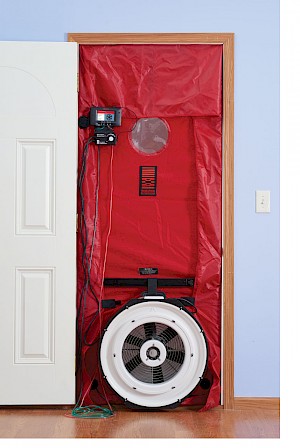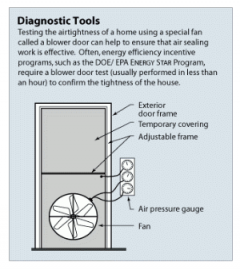Franklin Energy’s Product Division, AM Conservation, Agrees to Acquire Energy Federation, Inc.
Home Energy Audits 101: Blower Door Test
 Energy Federation Incorporation
Energy Federation Incorporation
 When you schedule a home energy audit, numerous parts of your home are inspected and checked for possible upgrades and improvements that can help you save energy and money on your utility bills. One test your auditor may perform is a blower door test and while setting up a blower door kit may look more like a scene from an alien invasion movie, it actually works really well to test how airtight a home is and can help determine where there are leaks.
When you schedule a home energy audit, numerous parts of your home are inspected and checked for possible upgrades and improvements that can help you save energy and money on your utility bills. One test your auditor may perform is a blower door test and while setting up a blower door kit may look more like a scene from an alien invasion movie, it actually works really well to test how airtight a home is and can help determine where there are leaks.
Diagnosing the Problem
First off, what are some of the reasons you’d want to perform a blower door test and determine if there are leaks? According to energy.gov, some of the reasons proper building tightness is ideal are:
- Reducing energy consumption due to air leakage
- Avoiding moisture condensation problems
- Avoiding uncomfortable drafts caused by cold air leaking in from the
outdoors
- Determining how much mechanical ventilation might be needed to
provide acceptable indoor air quality.
How Do They Work?
Blower door kits help the auditor (or homeowner) determine how much air gets into your home by depressurizing the building and seeking out the problem areas where new air comes in from the outside.
There are three primary components to a blower door that are all essential to complete the test:
- The fan that induces a range of airflows sufficient to pressurize and depressurize homes and various buildings in a range of sizes
- The manometer, a pressure measurement instrument that can simultaneously measure the pressure across the face of the fan and across the span of the home using the airflow moving through the fan
- The mounting system that connects the fan to the door or window being used for the test.
The test begins by turning off all devices that alter airflow (HVAC systems, fans, etc.). Then, the blower door kit is mounted on an external-facing door frame (such as your front door) and the air pressure is measured on the outside of the house as well as the inside of the house.
As the test begins, the fan in the door sucks all the air out of the home in order to depressurize the home. This gives the auditor a starting point to perform the search for air leaks. Once depressurized, a house with leaks will naturally begin to allow new air in from the outside. The fan in the blower door kit (along with the manometer) can then begin measuring the airflow and the amount of air leakage can then be calculated.

Once leaks are identified, your auditor can make suggestions as to how to remedy the leaks. There are many ways to manage leaks in your home in order to become more energy-efficient and participating in a home energy audit is a fantastic way to ensure you find the weak spots in your home that need upgrading.
Subscribe
Resources
Latest Updates
Customer Testimonials
Lets Talk!
Reach your customers & Exceed your goals
Contact EFI